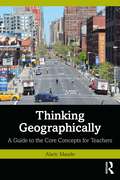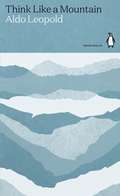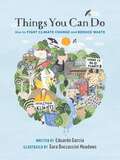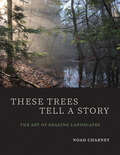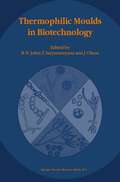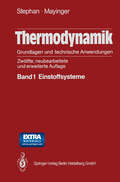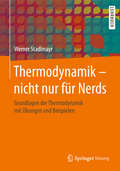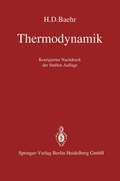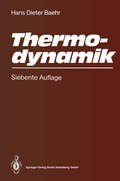- Table View
- List View
Thinking Geographically: A Guide to the Core Concepts for Teachers
by Alaric MaudeThis book explains how the concepts of geography can teach young people to think geographically, deeply and ethically. Thinking Geographically demonstrates how the concepts of place, space, environment and interconnection teach students new ways of perceiving and understanding the world, the concepts of scale and time teach them ways of analysing the world, while the concepts of sustainability and wellbeing show them how to evaluate and reflect on what they observe, and all eight concepts develop their higher order and critical thinking. To further support teachers, this book includes a chapter on how to teach for conceptual understanding, as well as two chapters that illustrate the application of geographical thinking to an understanding of the effects of land cover change and the problem of regional inequality. Rich with practical examples, this book is an essential resource for geography teachers, whether already teaching or studying to become one, and for those who teach therm.
Think Like a Mountain (Green Ideas)
by Aldo LeopoldIn twenty short books, Penguin brings you the classics of the environmental movement.In this lyrical meditation on America's wildlands, Aldo Leopold considers the different ways humans shape the natural landscape, and describes for the first time the far-reaching phenomenon now known as 'trophic cascades'.Over the past 75 years, a new canon has emerged. As life on Earth has become irrevocably altered by humans, visionary thinkers around the world have raised their voices to defend the planet, and affirm our place at the heart of its restoration. Their words have endured through the decades, becoming the classics of a movement. Together, these books show the richness of environmental thought, and point the way to a fairer, saner, greener world.
Things You Can Do: How to Fight Climate Change and Reduce Waste
by Eduardo GarciaWhat if we could help to save our planet through small habit changes in our homes? Learn what you can do right now to live a greener life your carbon footprint with this inspiring, accessible, stunningly illustrated book based on Eduardo Garcia's popular New York Times column.Award-winning climate journalist Eduardo Garcia offers a deeply researched and user-friendly guide to the things we can do every day to fight climate change. Based on his popular New York Times column "One Thing You Can Do," this fully illustrated book proposes simple solutions for an overwhelming problem. No lectures here - just accessible and inspiring ideas to slash emissions and waste in our daily lives, with over 350 explanatory illustrations by talented painter Sara Boccaccini Meadows.In each chapter, Garcia digs into the issue, explaining how everyday choices lead to carbon emissions, then delivers a wealth of 'Things You Can Do' to make a positive impact, such as:- Eat a climate-friendly diet - Reduce food waste- Save energy at home- Adopt zero-waste practicesPrinted on environmentally-friendly paper and delivering a decisive hit of knowledge with every turn of the page, Things You Can Do is the book for people who want to know more - and do more - to save the planet.
Thin Liquid Films: Dewetting and Polymer Flow (Theoretical and Mathematical Physics)
by Ralf BlosseyThis book is a treatise on the thermodynamic and dynamic properties of thin liquid films at solid surfaces and, in particular, their rupture instabilities. For the quantitative study of these phenomena, polymer thin films (sometimes referred to as “ultrathin”) have proven to be an invaluable experimental model system. What is it that makes thin film instabilities special and interesting? First, thin polymeric films have an important range of applications. An understanding of their instabilities is therefore of practical relevance for the design of such films. The first chapter of the book intends to give a snapshot of current applications, and an outlook on promising future ones. Second, thin liquid films are an interdisciplinary research topic, which leads to a fairly heterogeneous community working on the topic. It justifies attempting to write a text which gives a coherent presentation of the field which researchers across their specialized communities might be interested in. Finally, thin liquid films are an interesting laboratory for a theorist to confront a well-established theory, hydrodynamics, with its limits. Thin films are therefore a field in which a highly fruitful exchange and collaboration exists between experimentalists and theorists. The book stretches from the more concrete to more abstract levels of study: we roughly progress from applications via theory and experiment to rigorous mathematical theory. For an experimental scientist, the book should serve as a reference and guide to what is the current consensus of the theoretical underpinnings of the field of thin film dynamics. Controversial problems on which such a consensus has not yet been reached are clearly indicated in the text, as well as discussed in a final chapter. From a theoretical point of view, the field of dewetting has mainly been treated in a mathematically ‘light’ yet elegant fashion, often making use of scaling arguments. For the untrained researcher, this approach is not always easy to follow. The present book attempts to bridge between the ‘light’ and the ‘rigorous’, always with the ambition to enhance insight and understanding - and to not let go the elegance of the theory.
Thin Films of Soft Matter (CISM International Centre for Mechanical Sciences #490)
by S. Kalliadasis Uwe ThieleThis book provides a detailed overview and comprehensive analysis of the main theoretical and experimental advances on free surface thin film and jet flows of soft matter. The book outlines the basic equations and boundary conditions and the derivation of low-dimensional models for the evolution of the free surface. At the experimental front, a variety of recent experimental developments is outlined and the link between theory and experiments is illustrated.
These Trees Tell a Story: The Art of Reading Landscapes
by Noah CharneyA deeply personal master class on how to read a natural landscape and unravel the clues to its unique ecological history Structured as a series of interactive field walks through ten New England ecosystems, this book challenges readers to see the world through the eyes of a trained naturalist. With guided questions, immersive photography, and a narrative approach, each chapter adds layers of complexity to a single scene, revealing the millions of years of forces at play. Tying together geology, forest ecology, wildlife biology, soil processes, evolution, conservation, and more, Noah Charney shows how and why landscapes appear in their current forms. Charney’s stories and lessons will provide anyone with the necessary investigative skills to look at a landscape, interpret it, and tell its story—from its start as rock or soil to the plants and animals that live on it. Ultimately, Charney argues, by critically engaging with the landscape we will become better at connecting with nature and ourselves.
Thermotropic Liquid Crystals, Fundamentals (Springer Series in Chemical Physics #45)
by Ger Vertogen Wim H. JeuThe aim of this book is to give a unified and critical account of the fundamental aspects of liquid crystals. Preference is given to discussing the assumptions made in developing theories and analyzing experimental data rather than to attempting to compile all the latest results. The book has four parts. Part I is quite descriptive in character and gives a general overview of the various liquid crystalline phases. Part II deals with the macroscopic continuum theory of liquid crystals and gives a systematic development of the theory from a tensorial point of view thus emphasizing the relevant symmetries. Part III concentrates on experiments that provide microscopic information on the orientational behaviour of the molecules. Finally Part IV discusses the theory of the various phases and their attendant phase transitions from both a Landau and a molecular-statistical point of view. Simplifying the various models as far as possible, it critically examines the merits of a molecular-statistical approach.
Thermospheric Winds and Their Influence on the Ionosphere: (Review) (Mitteilungen aus dem Max-Planck-Institut für Aeronomie #53)
by R. RüsterIt is well known that thermospheric winds play an important role in the dynamics of the upper atmo sphere and are of major importance for the behaviour of the ionosphere. The methods of calculating these winds are discussed briefly. Comparisons of the calculated winds with observational data are carried out. Some main effects of the winds on the dynamical behaviour of the ionized as well as neutral part of the upper atmosphere are discussed. 2. Calculation of thermospheric winds The system of equations describing the dynamical behaviour of the thermosphere and the ionosphere consists of: b a neutral atmosphere ionosphere continuity equations continuity equations for different ion species and electrons equations of motion (winds) equations of motion for the different constituents (ambi polar diffusion, wind induced drifts, ~ x ~ -drifts) energy balance equations energy balance equations Due to collisions between charged and neutral particles there is an interaction between the ionized and neutral gas. Both sets of equations are coupled, therefore, by the respective drag terms. Because of the complexity of the mathematics involved in solving all equations simultaneously, different approaches have been made to solve parts of this system of differential equations under additional assumptions and restrictions. There are two general approaches: a. ) Solution of the equation of motion of the neutral atmosphere together with the ionospheric continuity equations and equations of motion of the ions.
Thermospheric Density and Wind Determination from Satellite Dynamics (Springer Theses)
by Eelco DoornbosThe Earth's atmosphere is often portrayed as a thin and finite blanket covering our planet, separate from the emptiness of outer space. In reality, the transition is gradual and a tiny fraction of the atmophere gases is still present at the altitude of low orbiting satellites. The very high velocities of these satellites ensure that their orbital motion can still be considerably affected by air density and wind. This influence can be measured using accelerometers and satellite tracking techniques. The opening chapters of this thesis provide an excellent introduction to the various disciplines that are involved in the interpretation of these observations: orbital mechanics, satellite aerodynamics and upper atmospheric physics. A subsequent chapter, at the heart of this work, covers advances in the algorithms used for processing satellite accelerometry and Two-Line Element (TLE) orbit data. The closing chapters provide an elaborate analysis of the resulting density and wind products, which are generating many opportunities for further research, to improve the modelling and understanding of the thermosphere system and its interactions with the lower atmosphere, the ionosphere-magnetosphere system and the Sun.
Thermophilic Moulds in Biotechnology
by B. N. Johri T. Satyanarayana J. OlsenAll important aspects of thermophilic moulds such as systematics, ecology, physiology and biochemistry, production of extracellular and intracellular enzymes, their role in spoilage of stores products and solid and liquid waste management, and general and molecular genetics have been dealt with comprehensively by experts in this book which covers progress in the field over the last 30 years since the seminal book Thermophilic Fungi published by Cooney and Emerson in 1964. The experts have reviewed extensive literature on all aspects of thermophilic moulds in a very comprehensive manner. This book will be useful for graduates as well as post-graduate students of life sciences, mycology, microbiology and biotechnology, and as a reference book for researchers.
Thermofluid Dynamics of Turbulent Flows: Fundamentals and Modelling (UNIPA Springer Series)
by Michele CiofaloThe book provides the theoretical fundamentals on turbulence and a complete overview of turbulence models, from the simplest to the most advanced ones including Direct and Large Eddy Simulation. It mainly focuses on problems of modeling and computation, and provides information regarding the theory of dynamical systems and their bifurcations. It also examines turbulence aspects which are not treated in most existing books on this subject, such as turbulence in free and mixed convection, transient turbulence and transition to turbulence. The book adopts the tensor notation, which is the most appropriate to deal with intrinsically tensor quantities such as stresses and strain rates, and for those who are not familiar with it an Appendix on tensor algebra and tensor notation are provided.
Thermoelectric Skutterudites
by Ctirad UherThis book informs the reader about a fascinating class of materials referred to as skutterudites, the atomic lattice of which has large structural voids that can be filled by a variety of foreign species, spanning from alkali to alkaline to rare earth ions. The fillers, in their unique way, drastically modify the physical properties of the parent structure, giving rise to outstanding thermoelectric properties. This exciting material is of growing importance and is finding applications in a variety of different fields. This book will be of interest to researchers working in materials science, physics, and chemistry in addition to graduate students in these subjects. Features:• Gives a comprehensive account of all fundamental physical properties of skutterudites• Each major topic is accompanied by introductory sections and a further detailed theoretical treatment is provided in Appendices• Supported by many figures and a vast number of relevant references
Thermoelectric Skutterudites
by Ctirad UherThis book informs the reader about a fascinating class of materials referred to as skutterudites, the atomic lattice of which has large structural voids that can be filled by a variety of foreign species, spanning from alkali to alkaline to rare earth ions. The fillers, in their unique way, drastically modify the physical properties of the parent structure, giving rise to outstanding thermoelectric properties. This exciting material is of growing importance and is finding applications in a variety of different fields. This book will be of interest to researchers working in materials science, physics, and chemistry in addition to graduate students in these subjects. Features:• Gives a comprehensive account of all fundamental physical properties of skutterudites• Each major topic is accompanied by introductory sections and a further detailed theoretical treatment is provided in Appendices• Supported by many figures and a vast number of relevant references
Thermoelectric Power in Nanostructured Materials: Strong Magnetic Fields (Springer Series in Materials Science #137)
by Kamakhya Prasad Ghatak Sitangshu BhattacharyaThermoelastic Models of Continua (Solid Mechanics and Its Applications #118)
by D. IesanThis volume is concerned with the basic problems of the theory of thermoelasticity for three models of continuous bodies: materials with voids, micropolar solids and nonsimple bodies. Beginning with the basic laws of thermodynamics, the theory of thermoelastic materials with voids is treated. Two subsequent chapters cover the analysis of the linear theory of micropolar thermoelastic bodies. The book concludes with a study of nonsimple thermoelastic materials, which are characterised by the inclusion of higher gradients of displacement in the basic postulates. Relevant examples and exercises which illustrate the theory are given throughout the text. The book should be of interest to mathematicians and specialists working in the fields of elasticity, thermoelasticity, civil engineering and geophysics.
Thermoelastic Deformations (Solid Mechanics and Its Applications #48)
by D. Iesan Antonio ScaliaThe theory of thermoelasticity studies the interaction between thermal and mechan ical fields in elastic bodies. This theory is of interest both for the mathematical and technical point of view. Intense interest has been shown recently in this field owing to the great practical importance of dynamical effects in aeronautics, nu clear reactors, and its potential importance in cryogenic applications. This work is concerned mainly with basic problems of the theory of thermoelasticity. Ther moelasticity of polar materials and the theories of thermoelasticity with finite wave speeds are not considered here. The reader interested in these subjects will find a full account in the works of Nowacki [280], Chandrasekharaiah [60] and Ignaczak [195]. Our purpose in this work is to present a systematic treatment of some results established in the theory of thermoelasticity. On the whole, the subject matter is directed towards recent developments. Chapter 1 is concerned mainly with the development of the fundamental equa tions of the theory of thermoelasticity. The kinematics and primitive concepts associated with the basic principles are developed and emphasized only to the ex tent that they are needed in our treatment of the subject. Chapter 2 is devoted to a study of linear thermoelastic deformations for prestressed bodies. We have at tempted to isolate those conceptual and mathematical difficulties which arise over and above those inherent in the problems concerned with unstressed bodies.
Thermodynamische Potenziale und Zustandssumme: Ein Überblick über die Definitionen in der Thermodynamik (essentials)
by Klaus StierstadtDieses essential gibt einen Überblick über die Definitionen und die Bedeutung thermodynamischer Potenziale und ermöglicht auch Einsteigern ein Verständnis der Thematik, welche eine Voraussetzung für die moderne Physik, die Chemie, Biologie und Technik ist. Der Schwerpunkt liegt auf den Grundlagen und aktuellen Fragestellungen. Es schlägt eine Brücke zwischen den beiden Thermodynamik-Vorlesungen: der einfachen Wärmelehre im 1. oder 2. Semester und der anspruchsvollen Statistischen Physik im 5. Semester. Das essential ist Teil einer dreiteiligen Reihe zur Thermodynamik zusammen mit Temperatur und Wärme – was ist das wirklich? und Die Eigenschaften der Stoffe: Suszeptibilitäten und Transportkoeffizienten.
Thermodynamik. Grundlagen und technische Anwendungen: Band 1: Einstoffsysteme (Springer-Lehrbuch #1)
by Karl Stephan Franz MayingerPraxisnahe Beschreibung der Grundlagen und der technischen Anwendungen, orientiert an einführenden Vorlesungen an TU, TH und FH: Anwendung des 1. Hauptsatzes auf stationäre und instationäre Prozesse in offenen und geschlossenen Systemen; ausführliche Behandlung des zweiten Haupttsatzes sowie technischer Kreisprozesse; weiterer Schwerpunkt: Zustandsgleichungen realer Gase, speziell für Wasserdampf. Abrundung durch Einführung in die Wärmeübertragung. Vereinigung der Vorzüge von Lehrbuch und Nachschlagewerk, auch für Praktiker und zum Selbststudium geeignet.
Thermodynamik. Grundlagen und technische Anwendungen: Band 2: Mehrstoffsysteme und chemische Reaktionen (Springer-Lehrbuch #2)
by Karl Stephan Franz MayingerDieses bewährte Thermodynamik-Lehrbuch zweier erfahrener Hochschullehrer behandelt in Band 2 Mehrstoffsysteme und chemische Reaktionen. Der Stoff wird wissenschaftlich streng, jedoch anschaulich und praxisnah dargestellt. Zahlreiche Übungsaufgaben helfen beim Verständnis. Das Buch vereint die Vorzüge eines Lehrbuches für Studenten an Universitäten und Technischen Hochschulen mit den positiven Eigenschaften eines Nachschlagewerkes für Praktiker.
Thermodynamik. Grundlagen und technische Anwendungen: Band 1: Einstoffsysteme (Springer-Lehrbuch #1)
by Karl Stephan Franz MayingerDie zwölfte Auflage unterscheidet sich von den vorangegangenen durch eine umfassende Neubearbeitung. Trotz vieler Änderungen waren wir aber bemüht, Ziel und Anlage des Buches zu erhalten. Es soll als Lehrbuch der Thermodynamik den Studierenden, vor allem den der lngenieurwissenschaften, mit den Grundlagen der Thermodynamik und ihren technischen Anwendungen vertraut machen. Die im Vergleich zu anderen Lehrbüchern reichliche Ausstattung mit Zahlenangaben für Stoffeigenschaften, die sich schon in den früheren Auflagen bewährte, wurde weiter beibehalten. Dadurch wird die Lösung praktischer Aufgaben erleichtert, und dem Leser bleibt das oft mühsame Suchen von Stoffwerten erspart. Besonderer Wert wurde auf eine anschauliche und praxisorientierte Darstel lung des Stoffes gelegt. Dies sollte dem Studierenden die Anwendung des Ge lernten erleichtern und dem bereits in der Praxis Tätigen die technische Verwert barkeit klarer demonstrieren. Die Thermodynamik wird von den Studierenden im allgemeinen als eines der schwierigeren Wissensgebiete angesehen, obwohl sie mit nur wenigen Lehr sätzen, neuen Begriffen und mathematischen Kenntnissen auskommt. Dies mag vor allem an den Schwierigkeiten liegen, die wenigen, aber abstrakten Grund lagen auf konkrete technische und physikalische Vorgänge anzuwenden. Es war daher unser Bestreben, die Grundlagen trotz aller gebotenen wissenschaftlichen Strenge stets so anschaulich wie möglich darzubieten, und wir haben außerdem, wie in den früheren Auflagen, unmittelbar im Anschluß an entwickelte Sätze die damit schon behandelbaren Anwendungen angeschlossen. Zahlreiche Übungs aufgaben, deren Lösungen man im Anhang findet, sollen zu eigenem Rechnen anleiten und den Stoff vertiefen.
Thermodynamik für das Bachelorstudium
by Klaus StierstadtDas Verständnis der Thermodynamik ist nicht nur Voraussetzung für die moderne Physik, Chemie, Biologie und Technik, sondern auch für die Frage der Energieversorgung der Zukunft. Der Autor führt in die Prinzipien, Methoden und Ergebnisse der Thermodynamik ein, indem er die Größen Temperatur, Wärme und Entropie auf die Eigenschaften der Atome und auf ihr Zusammenwirken zurückgeführt. Basierend auf den vier Hauptsätzen der Thermodynamik werden die wichtigsten Anwendungen, z. B. Energieumwandlung und Nanotechnologie, ausführlich besprochen.
Thermodynamik – nicht nur für Nerds: Grundlagen der Thermodynamik mit Übungen und Beispielen
by Werner StadlmayrThermodynamik muss kein unbeliebtes Fach bei Studierenden sein, das zeigen die Lehrveranstaltungen des Autors dieses Buches. Wie in seinen Lehrveranstaltungen baut er auch im Buch zuerst ein Grundverständnis für die teilweise sehr abstrakten Begriffe der Thermodynamik auf und verwendet eine einheitliche und durchgängige Nomenklatur. Dadurch macht er die Grundlagen auch dem Anfänger verständlich. Im zweiten Schritt folgen erst die mathematischen Operationen, die letztendlich zur erfolgreichen und befriedigenden Anwendung der Materie führen. Viele übersichtliche Diagramme und zahlreiche Übungen helfen für eine gute Vorbereitung auf Prüfungen und für das spätere Berufsleben.
Thermodynamik: Eine Einführung in die Grundlagen und ihre technischen Anwendungen
by H. D. BaehrVI wendungen verknüpft. Der Student erwirbt dabei zwar eine gewisse Fertigkeit im Umgang mit Formeln für technische Sonderfälle; ihm fehlt aber oft ein tieferes Verständnis für die logischen Zusammenhänge, und er versteht häufig nicht, Grundlegendes und Allgemeingültiges von dem zu unterscheiden, was nur unter einschränkenden Voraus setzungen für einen besonderen Anwendungsfall gilt. Ich habe mich daher bemüht, die Grundlagen dcr Thermodynamik ausführlich, in hinreichender logischer Strenge und so allgemein wie nötig darzustellen. Auch der größte Teil der Umarbeitungen, Ergänzungen und Erweite rungen diente der klareren Darstellung grundlegender Zusammen hänge. Stofflichen Erweiterungen wurden Kürzungen entgegengestellt, und manchmal brachte die Umarbeitung auch eine Straffung des Textes mit sich, so daß der Umfang des Buches gegenüber der zweiten Auf lage etwas verringert werden konnte. Von den zahlreichen Änderungen möchte ich die folgenden nennen. Der Arbeitsbegriff fand in Kapitel 2 eine genauere und eingehendere Darstellung, insbesondere wurde auch die Arbeit am Element eines strömenden Fluids behandelt, für das auch die besondere Form des 1. Hauptsatzes angegeben wird. Die in den früheren Auflagen gebrachte Einführung der Entropie (Kapitel 3) habe ich verallgemeinert und mit ausführlichen Beweisen versehen, um die Ergebnisse neuerer axiomati scher Untersuchungen, Stellung und Bedeutung von Caratheodorys Unerreichbarkeitsaxiom betreffend, zu berücksichtigen. Die früher nur kurz erwähnten Begriffe Entropieströmung und Entropieerzeugung habe ich ausführlich und auch in ihrer Anwendung auf technische Probleme dargestellt, wobei die mit der Entropieerzeugungeng verknüpfte Dissi pationsenergie neu eingeführt wurde.
Thermodynamik: Eine Einführung in die Grundlagen und ihre technischen Anwendungen
by Hans D. BaehrDieses Lehrbuch der Thermodynamik hat sich in vielen Auflagen und Sprachen bewährt; es liegt jetzt in einer grundlegenden und erweiterten Fassung vor. Die Stoffauswahl dieser gründlichen und verständlichen Einführung orientiert sich an den Lehrinhalten einführender Vorlesungen der Thermodynamik und Energietechnik. Neben den Energiebilanzen des ersten Hauptsatzes wird der zweite Hauptsatz besonders ausführlich dargestellt unter Einschluß des Exergiebegriffs, der für die Bewertung von Energieumwandlung wichtig ist. Erstmals werden auch die thermodynamischen Aspekte aller wesentlichen Teile der Energietechnik umfassend behandelt: Stationäre Fließprozesse, Verbrennungsprozesse und Verbrennungskraftanlagen, thermische Kraftwerke, Heizsysteme und Kälteanlagen. Dabei wurden Abschnitte über Wärmeübertrager, die Gasturbine als Flugzeugantrieb, Verbrennungsmotoren, Kernkraftwerke, kombinierte Gas-Dampf-Kraftwerke, die Kraft-Wärme-Kopplung, Wärmepumpen und die Wärmetransformation neu aufgenommen. Diese moderne und umfassende Darstellung der technischen Thermodynamik eignet sich als Lehrbuch für Studierende an Universitäten und Fachhochschulen und gleichermaßen als Nachschlagewerk für den in der Praxis tätigen Ingenieur. Nachdem die Vorauflage grundlegend überarbeitet und erweitert worden war, sind in dieser Auflage im wesentlichen Druckfehler beseitigt und kleinere Verbesserungen vorgenommen worden.
